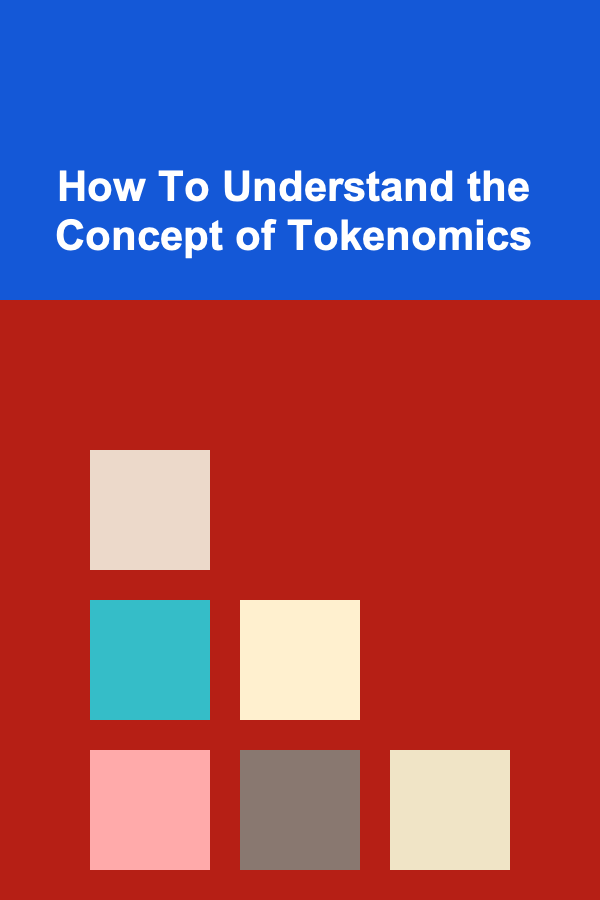
How To Understand the Concept of Tokenomics
ebook include PDF & Audio bundle (Micro Guide)
$12.99$11.99
Limited Time Offer! Order within the next:

In the world of cryptocurrencies and blockchain technology, the term "Tokenomics" has become a pivotal concept. Understanding tokenomics is crucial for anyone looking to engage with blockchain projects, cryptocurrencies, or decentralized finance (DeFi) applications. Tokenomics, as a blend of the words "token" and "economics," refers to the study of the economic systems that govern the issuance, distribution, and use of tokens within a blockchain ecosystem. This article dives deep into tokenomics, examining its various components and explaining its importance to investors, developers, and participants in blockchain projects.
What Is Tokenomics?
Tokenomics is the study of the economic model that surrounds a cryptocurrency or token within a specific blockchain ecosystem. It includes the design of how tokens are created, distributed, traded, and how they function within the network. In essence, tokenomics is the framework that governs the value and use of digital tokens, which serve as both a medium of exchange and a store of value in the decentralized world.
The concept combines elements of economics, finance, and game theory to incentivize behaviors that ensure the health and sustainability of a blockchain project. It involves decisions regarding the total supply of tokens, their distribution mechanisms, and how they will be utilized within the network.
Tokenomics plays a critical role in determining the success or failure of a project. A well-designed tokenomics structure can attract investors, encourage network participation, and help the project thrive in the long term. On the other hand, poor tokenomics can lead to inflationary pressures, reduced demand for tokens, and the collapse of the project's value proposition.
Key Components of Tokenomics
To fully understand tokenomics, it is essential to break it down into its core components. These components influence both the short-term price dynamics and the long-term success of a blockchain ecosystem.
1. Token Supply
Token supply refers to the total number of tokens that will ever exist in the ecosystem. There are different models for determining token supply, and each has a significant impact on the token's value and how the market perceives it.
Fixed Supply
A fixed supply means that the total number of tokens is predetermined and cannot be altered. Bitcoin, for example, has a fixed supply of 21 million coins, which creates scarcity and is often seen as a deflationary model. The finite nature of the token supply is a key factor in Bitcoin's value proposition, as it is resistant to inflation.
Inflationary Supply
Inflationary supply models involve the continuous creation of new tokens over time. Ethereum, for instance, does not have a fixed supply, and new tokens are created through mining or staking rewards. This can result in inflationary pressures over time unless mechanisms are implemented to limit supply increases.
Deflationary Supply
A deflationary supply model includes mechanisms that reduce the total supply of tokens over time. This can be achieved through token burning (destroying tokens) or buyback programs that remove tokens from circulation. Deflationary models aim to increase scarcity and, potentially, the value of each remaining token.
2. Token Distribution
Token distribution refers to how tokens are allocated across different stakeholders, including the founding team, investors, users, and the community. A fair and balanced distribution is crucial for the long-term success of the project, as it ensures that no single party can control the majority of the tokens or manipulate the network.
Initial Coin Offering (ICO) / Token Sale
Many blockchain projects use ICOs or token sales to distribute their tokens to the public in exchange for funds that will support the development of the project. In these sales, tokens are often sold at a discounted rate to early investors. ICOs can be a significant source of capital for new projects but can also present risks, as they are often unregulated and prone to fraud.
Airdrops and Staking Rewards
Airdrops are a popular way to distribute tokens to users for free, usually as a marketing strategy or to reward existing participants. Staking rewards are another method of distribution, where token holders are incentivized to lock up their tokens in the network to help secure the blockchain in exchange for additional tokens.
Founder and Team Allocation
The allocation of tokens to the founding team and key contributors is an important part of the distribution process. However, token allocations to the team should be carefully structured to avoid the perception of centralization or favoritism. Vesting periods are often implemented, ensuring that team members cannot sell or liquidate their tokens immediately after receiving them.
3. Token Utility
Token utility refers to the purpose or function that a token serves within the blockchain ecosystem. The utility of a token is the primary factor that determines its demand and use case. Tokens may have different utilities, including:
Medium of Exchange
Some tokens are used as a medium of exchange within the ecosystem, allowing users to pay for services, access features, or interact with decentralized applications (dApps). Ether (ETH) is an example of a token used as a medium of exchange within the Ethereum network.
Governance Token
Governance tokens allow holders to participate in the decision-making process of the network. Token holders can vote on proposals regarding the development of the protocol, changes to the ecosystem, or the allocation of funds. This system empowers users to have a say in the direction of the project and helps decentralize the governance process.
Staking and Rewards
Tokens can also be used for staking purposes. Staking allows participants to lock up tokens in a network to help secure it, and in return, they receive rewards. This incentivizes users to hold and stake their tokens rather than sell them, which can lead to a more stable and engaged community.
4. Token Demand
Token demand is a fundamental factor in tokenomics. A token's value is often driven by its demand within the ecosystem. Demand can be influenced by several factors:
- Network Growth: As more users join the network and use the token for transactions or services, demand increases, driving up its value.
- Adoption: Widespread adoption of the token as a medium of exchange or a governance tool can lead to higher demand.
- Scarcity: As discussed earlier, scarcity, whether through a fixed supply or deflationary mechanisms, can increase demand for the token.
- Speculation: Market speculation, driven by price movements or potential future utility, can create a temporary increase in demand.
5. Token Incentives
Token incentives refer to the ways in which tokens are used to encourage certain behaviors within the ecosystem. These incentives can drive network growth, encourage participation, and promote healthy behaviors.
Reward Systems
Reward systems, such as staking rewards or mining rewards, encourage users to lock up their tokens or provide value to the network. These rewards can be structured in a way that balances incentives for both short-term and long-term participants.
Penalties and Token Burn Mechanisms
Penalties, such as slashing (reducing the amount of tokens) for malicious behavior, can ensure that participants adhere to the rules of the network. Token burn mechanisms remove tokens from circulation, reducing supply and, in turn, potentially increasing value.
6. Token Governance
Governance is a crucial aspect of tokenomics. Governance allows token holders to have a say in the evolution of the project, from protocol changes to funding decisions. Decentralized governance ensures that no single entity has complete control over the blockchain project.
Governance tokens are typically used in decentralized autonomous organizations (DAOs), where decisions are made collectively by token holders. This structure empowers users to propose and vote on changes, ensuring that the project evolves in a way that reflects the needs and desires of its community.
The Importance of Tokenomics in Blockchain Projects
Tokenomics is often the deciding factor in whether a blockchain project succeeds or fails. It provides the foundational structure upon which the network operates, creating incentives that attract users, investors, and developers. When tokenomics is designed well, it fosters network growth, enhances engagement, and ensures the long-term viability of the ecosystem.
Without well-designed tokenomics, a blockchain project may face issues such as token inflation, centralization of control, low adoption, and a lack of network incentives. Poor tokenomics can lead to a loss of trust among participants, resulting in a decline in the token's value and ultimately the failure of the project.
How To Evaluate Tokenomics
When evaluating a project's tokenomics, there are several key questions to ask:
- What is the total supply of tokens? A finite supply can create scarcity and value, while an inflationary supply can lead to devaluation.
- How are tokens distributed? A fair and decentralized distribution is important for ensuring that no single party can control the project.
- What is the utility of the token? Understanding how the token will be used within the ecosystem is critical for determining its long-term value.
- What incentives are in place? Reward and penalty structures should be designed to encourage healthy participation and growth within the ecosystem.
- Is governance decentralized? Token holders should have the ability to influence the future of the project through decentralized governance.
Conclusion
Tokenomics is a complex but essential component of any blockchain project. It determines how tokens are distributed, used, and valued within the ecosystem. By carefully designing tokenomics, projects can create incentives that drive growth, engagement, and long-term success.
Whether you're an investor, developer, or enthusiast, understanding tokenomics will provide you with the insights needed to evaluate blockchain projects and participate in the decentralized economy. By considering the key components of token supply, distribution, utility, demand, incentives, and governance, you can better navigate the ever-evolving world of cryptocurrencies and blockchain technology.

How to Deep Clean Your Home Seasonally
Read More
How to Maximize Returns Using Dividend Stocks
Read More
How to Set Up a Checklist for Testing Your Email Campaigns: An Actionable Guide
Read More
How to Plan a Healthy Diet for Athletes
Read More
How to Make Homemade Broths and Stocks
Read More
How to Plan a Vocal Warm-Up Rehearsal
Read MoreOther Products

How to Deep Clean Your Home Seasonally
Read More
How to Maximize Returns Using Dividend Stocks
Read More
How to Set Up a Checklist for Testing Your Email Campaigns: An Actionable Guide
Read More
How to Plan a Healthy Diet for Athletes
Read More
How to Make Homemade Broths and Stocks
Read More